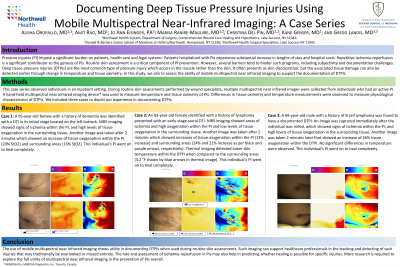Case Series/Study
(CS-110) Detecting deep tissue pressure injuries in an inpatient setting using mobile multispectral near infrared imaging: a case series

Catherine Chalupa, RN – Associate Clinical Professional Development Educator, Nursing Education, Northwell Health; Elizabeth Grahn, MSN – Senior Manager, Clinical Professional Development, Nursing Education, Northwell Health; Amit Rao, MD – Research Project Manager, Surgery, Northwell Health
Introduction: Pressure injuries impose a significant burden on patients, health care and legal systems. Patients hospitalized with PIs experience substantial increase in lengths of stay and hospital costs. Deep tissue pressure injuries (DTPIs) are the most common type of pressure injury which occurs in the muscle rather than the skin. It often presents as skin discoloration, but the associated tissue damage can also be detected earlier through change in temperature and tissue oximetry. In this study, we aim to assess the ability of mobile multispectral near infrared imaging to support the detection of DTPIs.
Methods: This study observed individuals in an inpatient setting. During routine skin assessments, multispectral near infrared images were collected from individuals who were at risk of developing a pressure injury. A hand-held mobile multispectral near infrared imaging device* was used to measure temperature and tissue oximetry of pressure areas. Differences in tissue oximetry and temperature measurements between pressure areas and a control site were observed to detect signs of a DTPI. We included three cases to depict our experience with detecting DTPIs.
Results: Three individuals with suspected DTPIs were selected for this case series. They were considered high risk for a pressure injury based on Braden risk assessment. Through multispectral imaging of the pressure area, a difference in tissue oximetry and temperature was observed. These individuals were followed to monitor the progression of their suspected DTPI.
Discussion: The use of mobile multispectral near infrared imaging shows utility in detecting DTPIs when used during routine skin assessments. Such imaging can support healthcare professionals in the tracking and detecting of such injuries that may traditionally be overlooked or missed entirely.
Trademarked Items: * MIMOSA Imager; MIMOSA Diagnostics Inc., Toronto, ON.
References:
Methods: This study observed individuals in an inpatient setting. During routine skin assessments, multispectral near infrared images were collected from individuals who were at risk of developing a pressure injury. A hand-held mobile multispectral near infrared imaging device* was used to measure temperature and tissue oximetry of pressure areas. Differences in tissue oximetry and temperature measurements between pressure areas and a control site were observed to detect signs of a DTPI. We included three cases to depict our experience with detecting DTPIs.
Results: Three individuals with suspected DTPIs were selected for this case series. They were considered high risk for a pressure injury based on Braden risk assessment. Through multispectral imaging of the pressure area, a difference in tissue oximetry and temperature was observed. These individuals were followed to monitor the progression of their suspected DTPI.
Discussion: The use of mobile multispectral near infrared imaging shows utility in detecting DTPIs when used during routine skin assessments. Such imaging can support healthcare professionals in the tracking and detecting of such injuries that may traditionally be overlooked or missed entirely.
Trademarked Items: * MIMOSA Imager; MIMOSA Diagnostics Inc., Toronto, ON.
References:

.png)
